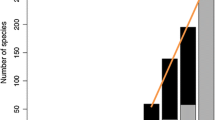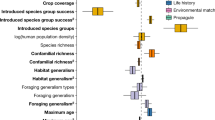Abstract
Several studies have argued that principal factor in determining the fate of bird introductions is introduction effort. In large part, these studies have emerged from analyses of historical records from a single place—New Zealand. Here we raise two concerns about these conclusions. First, we argue that although many bird species were introduced repeatedly to New Zealand, in many cases the introductions apparently occurred only after the species were already successfully naturalized. The inclusion of such seemingly superfluous introductions may exaggerate the importance of propagule pressure. And second, we question the reliability of the records themselves. In many cases these records are equivocal, as inconsistencies appear in separate studies of the same records. Our analysis indicates that species were successful not because they were introduced frequently and in high numbers, but rather it is likely that they were introduced frequently and in high numbers because the initial releases were successful.




Similar content being viewed by others
References
Andersen JC (1916) Jubilee history of South Canterbury. Whitcombe and Tombs, Auckland
Baiser B, Russell GJ, Lockwood JL (2010) Connectance determines invasions success via trophic interactions in model food webs. Oikos 119:1970–1976
Blackburn TM, Lockwood JL, Cassey P (2009) Avian invasions: the ecology and evolution of exotic birds. Oxford University Press, Oxford
Brooke RK, Moulton MP, Lockwood JL (1995) Patterns of success in passeriform introductions on Saint Helena. Oecologia 103:337–342
Buller WL (1868) Wanganui Acclimatisation Society. Wellington Independent Rorahi XXII, Putanga 2622, 14 Kohitatea 1868, p 5
Buller WL (1888) A history of the birds of New Zealand, 2nd edn. Published by the author, London
Case TJ (1996) Global patterns in the establishment and distribution of exotic birds. Biol Conserv 78:69–96
Cassey P, Blackburn TM, Sol D, Duncan RP, Lockwood JL (2004) Global patterns of introduction effort and the establishment success of birds. Proc R Soc Lond B 271:S405–S408
Cassey P, Blackburn TM, Duncan RP, Gaston KJ (2005) Causes of exotic bird establishment across oceanic islands. Proc R Soc Lond B 272:2059–2063
Caughley G (1983) The deer wars: the story of deer in New Zealand. Heinemann, Auckland
Cochrane GR (1973) The general environment and biogeography. In: Williams GR (ed) The natural history of New Zealand. Reed, Wellington, pp 28–60
Colautti RI, Grigorovich IA, MacIsaac HJ (2006) Propagule pressure: a null model for biological invasions. Biol Invasions 8:1023–1037
Coulter JD (1973) Ecological aspect of the climate. In: Williams GR (ed) The natural history of New Zealand. Reed, Wellington, pp 28–60
Diamond JM, Veitch CR (1981) Extinctions and introductions in the New Zealand avifauna: cause and effect? Science 211:499–501
Druett J (1983) Exotic invaders: the introduction of plants and animals to New Zealand. Heinemann, Auckland
Drummond J (1907) Our feathered immigrants: evidence for and against introduced birds in New Zealand together with notes on the native avifauna. NZ Dept of Ag Div Biol & Hort Bull Num 16. John Mackay, Government Printer, Wellington
Duncan RP (1997) The role of competition and introductions effort in the success of passeriform birds introduced to New Zealand. Am Nat 149:903–915
Duncan RP, Forsyth DM (2006) Competition and the assembly of introduced bird communities. In: Cardotte MW, McMahon SM, Fukami T (eds) Conceptual ecology and invasion biology: reciprocal approaches to nature. Springer, Netherlands, pp 405–421
Duncan RP, Blackburn TM, Sol D (2003) The ecology of bird introductions. Annu Rev Ecol Syst 34:71–98
Dunlap TR (1997) Remaking the land: the acclimatization movement and anglo ideas of nature. J World Hist 8:303–319
Elton CS (1958) The ecology of invasions by animals and plants. Methuen and Co., Ltd., London
Farmer KL, Hill GE, Roberts SR (2005) Susceptibility of wild songbirds to the house finch strain of Mycoplasm gallisepticum. J Wildl Dis 41:317–325
Gamarra JGP, Montoya JM, Alonso D, Sole RV (2005) Competition and introduction regime shape exotic bird communities in Hawaii. Biol Invasions 7:297–307
Green RE (1997) The influence of numbers released on the outcome of attempts to introduced exotic bird species to New Zealand. J Anim Ecol 66:25–35
Heather B, Robertson H (1997) Field guide to the birds of New Zealand. Oxford University Press, Oxford
Juvik SP, Juvik JO (1998) Atlas of Hawai’i, 3rd edn. University of Hawai’i Press, Honolulu
Lamb RC (1964) Birds, beats and fishes. The North Canterbury Acclimatisation Society, Christchurch
Lockwood JL, Moulton MP (1994) Ecomorphological pattern in Bermuda birds: the influence of competition and implications for nature preserves. Evol Ecol 8:53–60
Lockwood JL, Moulton MP, Anderson SK (1993) Morphological assortment and the assembly of communities of introduced passerines on oceanic islands: Tahiti vs. Oahu. Am Nat 141:398–408
Lockwood JL, Moulton MP, Brooke RK (1996) Morphological dispersion of the introduced land-birds of Saint Helena. Ostrich 67:111–117
Lockwood JL, Cassey P, Blackburn T (2005) The role of propagule pressure in explaining species invasions. Trends Ecol Evol 20:223–228
Long JL (1981) Introduced birds of the world. David and Charles, London
McLain DK, Moulton MP, Redfearn TP (1995) Sexual selection and the risk of extinction: an analysis with introduced birds. Oikos 74:27–34
McLain DK, Moulton MP, Sanderson JG (1999) Sexual selection and extinction: the fate of plumage-dimorphic and plumage-monomorphic birds introduced onto islands. Evol Ecol Res 1:549–565
Moulton MP (1985) Morphological similarity and the coexistence of congeners: an experimental test using introduced Hawaiian birds. Oikos 44:301–305
Moulton MP (1993) The all-or-none pattern in introduced Hawaiian passeriforms: the role of competition sustained. Am Nat 140:105–119
Moulton MP, Pimm SL (1983) The introduced Hawaiian avifauna: biogeographic evidence for competition. Am Nat 121:669–690
Moulton MP, Pimm SL (1986a) The extent of competition in shaping an introduced avifauna. In: Diamond J, Case TJ (eds) Community ecology. Harper and Row, New York, pp 80–97
Moulton MP, Pimm SL (1986b) Species introductions to Hawaii. In: Mooney HA, Drake JA (eds) Ecology of biological invasions of North America and Hawaii. Ecological studies, vol 58. Springer, New York, pp 231–249
Moulton MP, Pimm SL (1987) Morphological assortment in introduced Hawaiian passerines. Evol Ecol 1:113–124
Moulton MP, Lockwood JL (1992) Morphological dispersion of introduced Hawaiian finches: evidence for competition and a Narcissus effect. Evol Ecol 6:45–55
Moulton MP, McLain DK, Moulton LE (2009) Sexual selection and the fate of introduced pigeons and doves (Aves: Columbidae). Evol Ecol Res 11:889–904
Moulton MP, Cropper WP, Avery ML, Moulton LE (2010) The earliest house sparrow introductions of North America. Biol Invasions 12:2955–2958
Munoz-Fuentes V, Vila C, Green AJ, Negro JJ, Sorenson MD (2007) Hybridization between white-headed ducks and introduced ruddy ducks in Spain. Mol Ecol 16:629–638
Oliver WRB (1955) New Zealand birds, 2nd edn. Reed, Wellington
Phillips JC (1928) Wild birds introduced and transplanted into North America. U S Dep Agric Tech Bull 61:1–63
Pimm SL (1991) The balance of nature? Ecological issues in the conservation of species and communities. University of Chicago Press, Chicago
Reaser JK, Meyerson LA, Van Holle B (2008) Saving camels from straws: how propagule pressure-based prevention policies can reduce the risk of biological invasion. Biol Invasions 10:1085–1098
Rhymer JM, Simberloff D (1996) Extinction by hybridization and introgression. Annu Rev Ecol Syst 87:83–109
Rhymer JM, Williams MJ, Braun MJ (1994) Mitochondrial analysis of gene flow between New Zealand Mallards (Anas platyrhynchos) and Grey Ducks (Anas superciliosa). Auk 111:970–978
Savidge JA (1987) Extinction of an island forest avifauna by an introduced snake. Ecology 68:660–668
Simberloff D (2009) The role of propagule pressure in biological invasions. Annu Rev Ecol Syst 40:81–102
Simberloff D, Boecklen W (1991) Patterns of extinction in the introduced Hawaiian avifauna: a reexamination of the role of competition. Am Nat 138:300–327
Smallwood KS (1994) Site invisibility by exotic birds and mammals. Biol Conserv 69:251–259
Sol D, Lefebvre L (2000) Behavioral flexibility predicts invasion success in birds introduced to New Zealand. Oikos 90:599–605
Sol D, Duncan RP, Blackburn TM, Cassey P, Lefebvre L (2005) Big brains, enhanced cognition, and response of birds to novel environments. Proc Natl Acad Sci 102:5460–5465
Sorci G, Moller AP, Clobert J (1998) Plumage dichromatism of birds predicts introduction success in New Zealand. J Anim Ecol 67:264–269
Thomson GM (1922) The naturalisation of plants and animals in New Zealand. Cambridge University Press, Cambridge
Thomson GM (1926) Wild life in New Zealand II. Introduced birds and fishes. Government Printer, Wellington
Van Houtan KS, Halley JM, van Aarde R, Pimm SL (2009) Achieving success with small translocated mammal populations. Conserv Lett 2:254–262
Veltman CJ, Nee S, Crawley MJ (1996) Correlates of introduction success in exotic New Zealand birds. Am Nat 147:542–557
Wall A (1927) Introduction. In: Speight R, Wall A, Lang RM (eds) Natural history of Canterbury. Simpson and Williams Limited, Christchurch, pp 1–3
Warner E (1968) The role of introduced diseases in the extinction of the endemic Hawaiian avifauna. Condor 70:101–120
Westerskov KE (1953) Introduction to New Zealand of the Australian blue wren in 1923. Notornis 5:106–107
Williams GR (1969) Introduced birds. In: Knox GA (ed) The natural history of Canterbury. Reed, Wellington, pp 435–451
Wilson JD, Dorcas ME, Snow RW (in press) Identifying plausible scenarios for the establishment of invasive Burmese pythons (Python molurus) in southern Florida. Biol Invasions. doi:10.1007/s10530-9908-3
Acknowledgments
We thank Stuart Pimm, Kyle Van Houtan and anonymous reviewers for very helpful comments on the manuscript.
Author information
Authors and Affiliations
Corresponding author
Appendix
Appendix
See Table 7.
Rights and permissions
About this article
Cite this article
Moulton, M.P., Cropper, W.P. & Avery, M.L. A reassessment of the role of propagule pressure in influencing fates of passerine introductions to New Zealand. Biodivers Conserv 20, 607–623 (2011). https://doi.org/10.1007/s10531-010-9969-8
Received:
Accepted:
Published:
Issue Date:
DOI: https://doi.org/10.1007/s10531-010-9969-8




